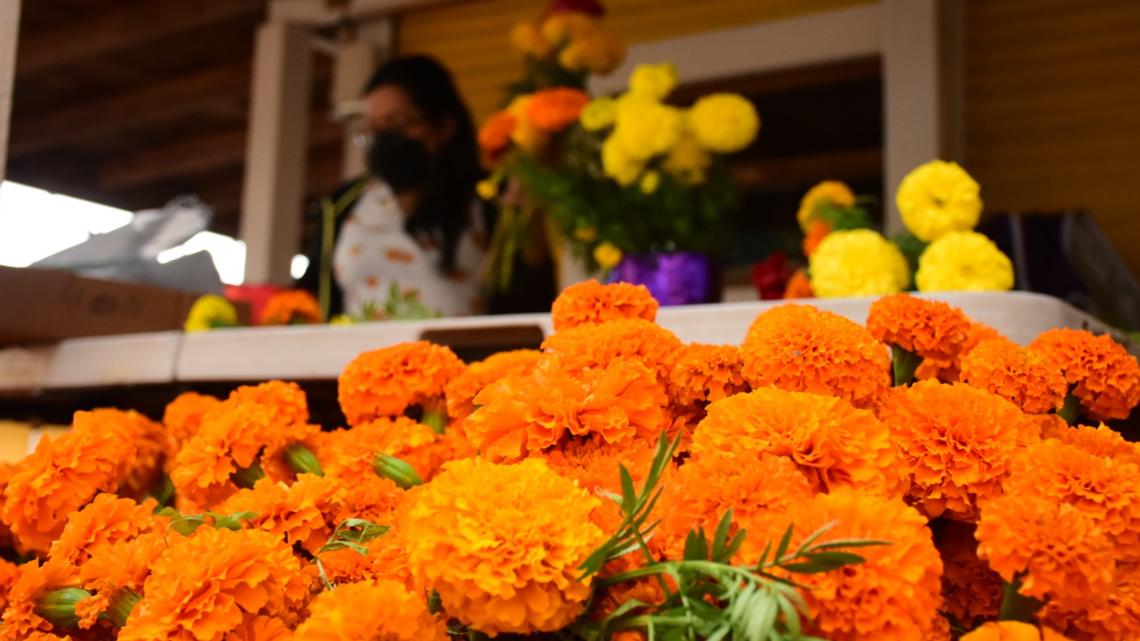To continue celebrating El Día de los Muertos, or ‘Days of the Dead’, this week we’re taking a look at marigolds. Marigolds are an important plant in not just this yearly festival, but across many other cultures now and throughout history, and did you know that they are edible too?
Originating in North and South America, marigolds, or Tagetes, are now grown across the world for their medicinal, cultural, culinary, and ornamental uses and are a member of the daisy family. However, these can be confused with pot marigolds, which while also part of the daisy family originate from southwestern Asia and western Europe.
Faiths and Cultures:
For thousands of years, marigolds have been a symbolic part of many cultures and are just as important today. The Aztecs, or Nahuatl, called marigolds ‘cempasúchil’, which means ‘twenty petals’ and comes from a folktale about two lovers who were turned into a hummingbird and a marigold!
During El Día de los Muertos, marigolds are used in the creation of offrendas, or altars, that decorate graves, and are sometimes called Flor de Muerto, or ‘Flower of the Dead’. In Hindi culture, marigolds are used to honour gods and godesses and are said to symbolise passion and creativity.
Medicinal Uses:
Marigolds have been used in many traditional medicines to treat a range of conditions from fever to malaria. In Mexico, the seeds are eaten raw or toasted to treat intestinal worms while the leaves and roots are made into a tea that is used as a laxative and to treat fever and stomach pains. Marigolds are also still used today to treat respiratory problems and even malaria!
The Nahuatl used marigolds to treat ‘cold’ diseases, which were conditions associated with dampness and excess bodily fluids, with symptoms including fevers, phlegm production, watery eyes, and swelling. Marigolds were also used to treat ‘divine’ diseases, such as gout, and ‘natural’ diseases, including swelling and blisters, and was even administered to sacrificial victims as an anaesthetic and hallucinogenic. Marigolds were also mixed with wild tobacco and smoked by the Huichols, an indigenous people of Mexico, for their psychotropic effects
Modern research has found that several species have potential analgesic (pain-relieving) and anti-inflammatory effects, while the roots and essential oils could be used as a potential method of repelling fungi, insects, and nematodes. Not only that, but marigolds also contain patuletin, a compound that has been found to relieve symptoms of rheumatoid arthritis. However, some species of marigolds have flowers that are toxic so you should consult a doctor or naturopath before using marigolds as a treatment.
Culinary Uses:
Marigolds are also quite useful in cooking, and the petals can be used in salads, as a garnish, and can even be cooked with rice to give it a yellow saffron colour. In particular, Mexican mint marigold has a flavour reminiscent of anise and can be used as a replacement for French tarragon. Other species can also taste of mint, sweet basil, and citrus, and dried leaves can be used as a seasoning, especially in fish dishes.
If you’re wondering how to use these gorgeous plants in your cooking, have a look through these great recipes:
Green and Gold Broccoli and Marigolds, Ode a la Rose
Arugula Pesto with Herbed Ricotta Gnocchi, Epicurious
Marigold Cheesecake, Taste of Home
Gardening Facts:
Marigolds are usually annuals or perennials with yellow, orange, and red flowers that pop up all the way from spring to autumn. Preferring warm areas with light, well-drained soil and lots of sunlight and water, marigolds can grow anywhere from 15 cm to 1.8 m tall! With aromatic leaves and vibrant flowers, marigolds also make a great addition to your garden to attract butterflies, ladybugs and other beneficial pollinators, predators, and even parasites!
Marigolds are frequently planted in gardens for their ability to deter pests, suppress weeds, and as a companion plant for tomatoes, eggplant, potatoes, and beans. Marigolds are able to deter pests by releasing thiophene, a compound mostly found in roots, into the soil and is especially effective in deterring aphids, whiteflies, and nematodes
With so many varieties to choose from and enjoy, happy planting, cooking and eating!
